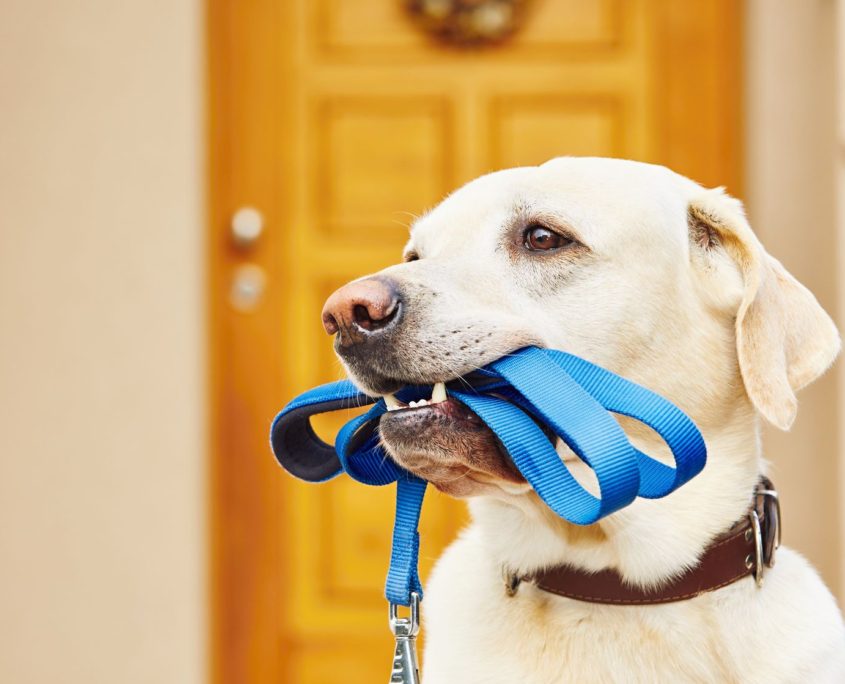6 Ways Your Dog Is Interpreting Your Actions
We’re sorry to tell you this but you must know. The message you think you are sending to your dog might be very different to the one your dog receives. You need to start looking at situations from a dog’s viewpoint in order to understand what’s really going on. Remember, actions speak louder than words.
Your dog pays attention to what you do much more than what you say. If you don’t understand this simple truth, you could be heading for all sorts of doggy disobedience. And it won’t be the dog’s fault.
Let’s start with a couple of straight-forward interpretation examples so you can see what we mean.
1. Barking and Whining
Your dog is barking and whining to be let out. You tell him to be quiet but you open the door anyway to stop the noise. You probably see where we’re heading with this, but let’s work it through properly. Here’s a simple tool you can use whenever you want to decode what’s happening from your dog’s perspective.
| Barking and Whining – Six Key Question Tool | |
| The Key Questions | What’s Really Happening? |
| 1. What’s the trigger? | Your dog has decided they should go outside (for any reason). |
| 2. What does your dog want? | To get out now. |
| 3. What’s your dog’s action? | Stand at the door and bark and whine. |
| 4. What’s your action? | You tell them to be quiet, but you let your dog out. |
| 5. Does your dog get what they want? | You bet they do! |
| 6. What dog behavior is rewarded? | Barking and whining |
So, barking and whining has been rewarded in this case.
2. Begging at the Dinner Table
You are eating dinner at the table and your dog begs for food. You tell him to sit and stop it, but he keeps looking at you as though he’s never been fed in his entire life. You give in and throw him a morsel.
| Begging at the Table – Six Key Question Tool | |
| The Key Questions | What’s Really Happening? |
| 1. What’s the trigger? | You sit down to the table for dinner. |
| 2. What does your dog want? | FOOD! |
| 3. What’s your dog’s action? | Beg at the table. |
| 4. What’s your action? | You tell your dog to sit and stop it, but you relent and give them some food. |
| 5. Does your dog get what they want? | You bet they do! |
| 6. What dog behavior is rewarded? | Begging at the table. |
And begging has been rewarded this time.
In both cases, it’s what you do, it’s your actions, that deliver rewards to your dog. Now dogs are smart when it comes to receiving rewards. If it works, they’ll keep doing it. Everything else is just noise. What you say doesn’t matter when your actions speak louder.
While you’re thinking about that, let’s dig up another common bone of misinterpretation. You Said What? Do you think your dog understands exactly what you are saying? Here’s another example to consider.
3. The Takeaways
Your dog barks at something (it doesn’t matter what). You tell them to be quiet, and when that doesn’t work you yell at them to be quiet. They don’t get the message.
Take away the meaning of the words you yell out, and what does your dog really hear? What do they think about it? You need to realize that dog’s barking, the sound component of their native communication, developed in the wild long before they became man’s best friend.
Imagine the barking scenario in a wild setting. Your dog detects something and raises the alert – he barks. You, (who are hopefully seen by your dog as the pack leader) start yelling.
From your dog’s perspective, you are barking too. If the pack leader is barking this must be a serious threat! Your dog had better bark some more…
Clearly, yelling at a barking dog isn’t the way to calm them down.
(You may be still protesting that your dog understands every word you say. Sure, dogs can learn to recognise some sound patterns, but they don’t really understand human speech. Sorry).
They do however pick up on our energy. And they do that very well indeed.
4. Pay Attention to the Energy You Put Out
Here are two examples where your dog interprets your energy perfectly.
- If you’re feeling sad and moping about, your dog comes up to you gently.
- If you’re jumping up and down, your dog joins in energetically.
These are both examples of your dog reading your body language and your energy, and then responding.
Knowing this gives us some clues on how we can better manage dog behavior. Using energy levels is especially good for controlling and defusing situations. Here’s our final example, with a little test thrown in for you.
5. Your Challenge
Your dog is on leash and another dog comes into sight. Your dog barks and pulls you toward the other dog. What do you do next? If you let your dog drag you to the other dog so they can meet, what behavior is being rewarded? Try using the Six Key Question Tool yourself for this one.
| Your Challenge – Six Key Question Tool | |
| The Key Questions | What’s Really Happening? |
| 1. What’s the trigger? | Your dog is on leash and sees another dog. |
| 2. What does your dog want? | To meet them, to play! |
| 3. What’s your dog’s action? | Bark and pull on the leash |
| 4. What’s your action? | You let your dog drag you over to the other dog. |
| 5. Does your dog get what they want? | You bet they do! |
| 6. What dog behavior is rewarded? | ? |
That’s right, barking and pulling on the leash has been rewarded. There’s no surprise that your dog will keep doing it!
So what is your alternative? Can you see it? Here are some thoughts to get you started.
- You need to create a situation where you can reward good behavior rather than bad.
- Obviously, you won’t let your dog drag you over to the other dog. What do you do instead?
- You know that your dog will pick up on your energy, and they are pretty excited at seeing that other dog. You need to calm things down before you let them meet.

6. It’s a Dog’s World
Always remember, your dog interprets your human actions from their doggy world view. It’s not always what you think. Understanding the difference is a huge step on the path to a better human-dog relationship. And that’s something we should all work towards.
About the Author: Brad & Denise at DIYDogProjects are passionate about improving the relationship between dogs and their owners. They believe the Number 1 DIY Dog Project is without a doubt dog behavior training ensuring a lasting and loving relationship between owners and their dogs – in a way that dogs understand!










Leave a Reply
Want to join the discussion?Feel free to contribute!